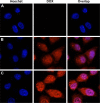Codelivery of doxorubicin and triptolide with reduction-sensitive lipid-polymer hybrid nanoparticles for in vitro and in vivo synergistic cancer treatment
- PMID: 28331310
- PMCID: PMC5352248
- DOI: 10.2147/IJN.S131235
Codelivery of doxorubicin and triptolide with reduction-sensitive lipid-polymer hybrid nanoparticles for in vitro and in vivo synergistic cancer treatment
Abstract
Codelivery is a promising strategy to overcome the limitations of single chemotherapeutic agents in cancer treatment. Despite progress, codelivery of two or more different functional drugs to increase anticancer efficiency still remains a challenge. Here, reduction-sensitive lipid-polymer hybrid nanoparticles (LPNPs) drug delivery system composed of monomethoxy-poly(ethylene glycol)-S-S-hexadecyl (mPEG-S-S-C16), soybean lecithin, and poly(D,L-lactide-co-glycolide) (PLGA) was used for codelivery of doxorubicin (DOX) and a Chinese herb extract triptolide (TPL). Hydrophobic DOX and TPL could be successfully loaded in LPNPs by self-assembly. More importantly, drug release and cellular uptake experiments demonstrated that the two drugs were reduction sensitive, released simultaneously from LPNPs, and taken up effectively by the tumor cells. DOX/TPL-coloaded LPNPs (DOX/TPL-LPNPs) exhibited a high level of synergistic activation with low combination index (CI) in vitro and in vivo. Moreover, the highest synergistic therapeutic effect was achieved at the ratio of 1:0.2 DOX/TPL. Further experiments showed that TPL enhanced the uptake of DOX by human oral cavity squamous cell carcinoma cells (KB cells). Overall, DOX/TPL-coencapsulated reduction-sensitive nanoparticles will be a promising strategy for cancer treatment.
Keywords: codelivery; reduction sensitive; synergistic effect; triptolide.
Conflict of interest statement
Disclosure The authors report no conflicts of interest in this work.
Figures









Similar articles
-
Folate-containing reduction-sensitive lipid-polymer hybrid nanoparticles for targeted delivery of doxorubicin.Biomater Sci. 2015 Apr;3(4):655-64. doi: 10.1039/c4bm00462k. Epub 2015 Mar 2. Biomater Sci. 2015. PMID: 26222425
-
pH-triggered charge-reversal and redox-sensitive drug-release polymer micelles codeliver doxorubicin and triptolide for prostate tumor therapy.Int J Nanomedicine. 2018 Nov 8;13:7229-7249. doi: 10.2147/IJN.S182197. eCollection 2018. Int J Nanomedicine. 2018. PMID: 30510415 Free PMC article.
-
Fabrication Of Dual pH/redox-Responsive Lipid-Polymer Hybrid Nanoparticles For Anticancer Drug Delivery And Controlled Release.Int J Nanomedicine. 2019 Oct 3;14:8001-8011. doi: 10.2147/IJN.S226798. eCollection 2019. Int J Nanomedicine. 2019. PMID: 31632014 Free PMC article.
-
Potential antitumor activity of triptolide and its derivatives: Focused on gynecological and breast cancers.Biomed Pharmacother. 2024 Nov;180:117581. doi: 10.1016/j.biopha.2024.117581. Epub 2024 Oct 19. Biomed Pharmacother. 2024. PMID: 39427548 Review.
-
Research Progress of Triptolide Against Fibrosis.Drug Des Devel Ther. 2024 Jul 25;18:3255-3266. doi: 10.2147/DDDT.S467929. eCollection 2024. Drug Des Devel Ther. 2024. PMID: 39081704 Free PMC article. Review.
Cited by
-
Magnetic And pH Dual-Responsive Nanoparticles For Synergistic Drug-Resistant Breast Cancer Chemo/Photodynamic Therapy.Int J Nanomedicine. 2019 Sep 18;14:7665-7679. doi: 10.2147/IJN.S214377. eCollection 2019. Int J Nanomedicine. 2019. PMID: 31571870 Free PMC article.
-
MRI-guided targeting delivery of doxorubicin with reduction-responsive lipid-polymer hybrid nanoparticles.Int J Nanomedicine. 2017 Sep 14;12:6871-6882. doi: 10.2147/IJN.S143048. eCollection 2017. Int J Nanomedicine. 2017. PMID: 29066883 Free PMC article.
-
Systemic dendrimer delivery of triptolide to tumor-associated macrophages improves anti-tumor efficacy and reduces systemic toxicity in glioblastoma.J Control Release. 2021 Jan 10;329:434-444. doi: 10.1016/j.jconrel.2020.12.003. Epub 2020 Dec 5. J Control Release. 2021. PMID: 33290796 Free PMC article.
-
A worldwide bibliometric analysis of triptolide research from 1997 to 2021.Am J Transl Res. 2022 Oct 15;14(10):7290-7307. eCollection 2022. Am J Transl Res. 2022. PMID: 36398275 Free PMC article.
-
Pharmaceutical Dispersion Techniques for Dissolution and Bioavailability Enhancement of Poorly Water-Soluble Drugs.Pharmaceutics. 2018 Jun 23;10(3):74. doi: 10.3390/pharmaceutics10030074. Pharmaceutics. 2018. PMID: 29937483 Free PMC article. Review.
References
-
- Gadde S. Multi-drug delivery nanocarriers for combination therapy. Med Chem Commun. 2015;6(11):1916–1929.
-
- Shastri L, Abdelhamid HN, Nawaz M, et al. Synthesis, characterization and bifunctional applications of bidentate silver nanoparticle assisted single drop microextraction as a highly sensitive preconcentrating probe for protein analysis. RSC Adv. 2015;5(52):41595–41603.
-
- Chen D, Wang G, Song W, et al. Novel CD44 receptor targeting multifunctional “nano-eggs” based on double pH-sensitive nanoparticles for co-delivery of curcumin and paclitaxel to cancer cells and cancer stem cells. J Nanopart Res. 2015;17(10):1–10.
MeSH terms
Substances
LinkOut - more resources
Full Text Sources
Other Literature Sources

